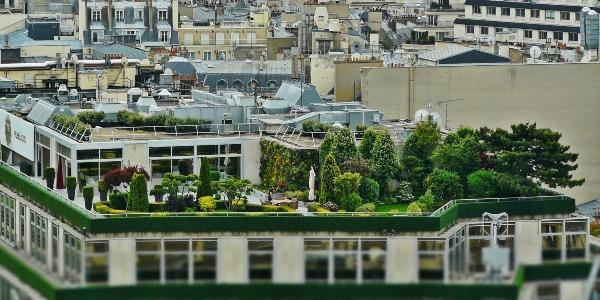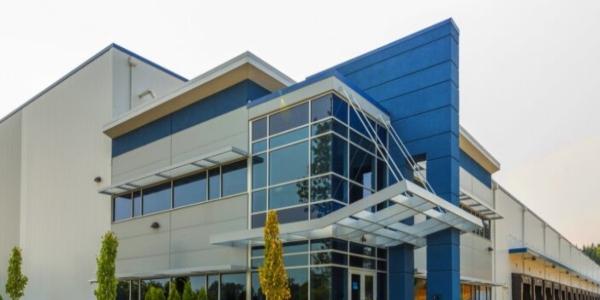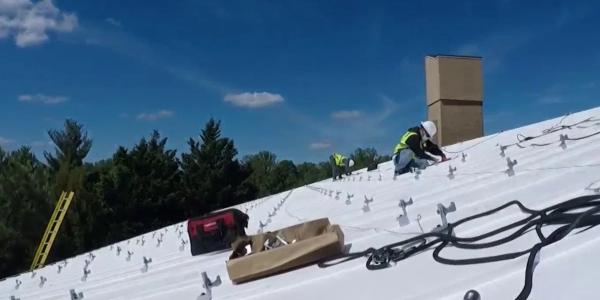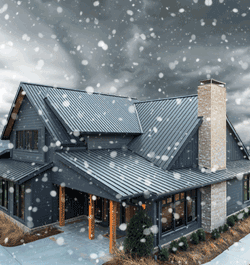Why Green Roofs are Better for Cities

By Cass Jacoby, RCS Reporter.
A rooftop garden is more than just a beautiful oasis for city dwellers to escape all of the concrete, it is actually better for the city as a whole.
Rooftop gardens might seem like a superfluous luxury in the city, but contrary to the assumption that a green roof is merely an aesthetic way to utilize the empty space of a roof, it actually serves a number of practical purposes. According to research from climate scientists at NASA’s Goddard Institute for Space Studies (GISS) in New York, green roofs can harness the cooling power of plants to lower the temperatures of cities.
The urban heat island effect is a result of urbanization, where heat is amplified due to all of the asphalt and concrete that retains and absorbs the heat. This heat often is worse in neighborhoods with fewer green spaces, and according to a research article disproportionately affects older adults, low-income communities and some communities of color. Thus, a green roof, which uses natural vegetation to reduce the roof’s temperature by absorbing energy from the sun is a logical solution to help cool cities.
According to Renewable and Sustainable energy reviews these types of roofs are able to reduce the solar heating of a building by reflecting 27% of solar radiation, absorbing 60% by the vegetation through photosynthesis and evapotranspiration, and absorbing the remaining 13% into the growing medium.
For the past few decades, researchers and scientists have been adamant about replacing dark-colored roofs with bright, sun-reflecting surfaces or green roofs that boast a healthy amount of plant cover in order to curb the urban heat island effect. However, with this new study, satellite data has been used to analyze precisely how effective these changes can be.
As published in Sustainable Cities and Society, two out of three green roofs reduce temperatures, but also the effectiveness of a green roof might be dependent on other factors like location and plant diversity.
“You might think that putting a green roof on your new building would make a significant impact. But what we see is that a lot of impervious material may also be added there – such as a parking lot around the building,” climate scientist and civil engineer at Columbia University and GISS Christian Braneon tells NASA. “As a result, you might reduce the impact of the parking lot, but you certainly haven’t created the cooling effect that the overgrown vegetation had."
As we continue to search for solutions to rising temperatures and cities continue to develop, the importance of thoughtful infrastructure becomes more and more apparent. “These decisions often last for 30 or 50 years or longer,” says Christian. “In the context of more frequent heat waves and more extreme heat, it’s important to understand how these urban design interventions can be effective.”
Still, the study represents a promising start to cooling our cities. Lead author Kathryn McConnell, a doctoral candidate at Yale University’s School of the Environment tells The Print that this analysis can be used by urban planners to assess the viability of green roofs in their own communities. “My hope would be that the methods we proposed show a low-cost way for folks working in less-resourced cities – who maybe don’t have access to a university or government researcher – to study their own communities,” she says.
That being said, there is already a significant amount of data on additional benefits of green roofs outside urban heat island mitigation including:
- Improved thermal performance. According to Roof Slope, garden roofs offer improved thermal performance and can make a significant difference in energy bills because they provide natural insulation.
- Stormwater runoff retention. Living Roofs reports that green roofs absorb up to 75% of rainfall, thus reducing the runoff dramatically and lowering the risk of flooding. Depending on the roof garden design, a green roof can typically reduce storm water run-off by 50% to 90%. Additionally, the peak flow volume is greatly reduced and the peak flow period is delayed by as much as four hours, minimizing the impact on existing sewer systems.
- Increased roof service life. Green roofing can extend a roof's lifespan by over 200% according to an article in the Journal of Environmental Management. By covering the waterproofing membrane with growing medium and vegetation, the plants shield the roof from ultra-violet radiation and physical damage.
- Better air quality. Garden roofs reduce greenhouse emissions, filter toxins from the air and produce oxygen. Plants produce oxygen and remove carbon dioxide from the air. They also trap up to 85% of airborne particulates on their leaf surfaces. Plants, soil and air trapped in the soil are great acoustic insulators, too. A green roof has the potential of reducing the amount of CO2 that’s released into the atmosphere.
- Biodiversity and ecosystem restoration potential. Creating more spaces in cities for greenery allows for an entire eco-system to thrive where it couldn’t before.
- Sound insulation. According to the journal Nature Based Strategies for Urban and Building Sustainability, green roofs have been found to mitigate sound waves over (parts of) roofs and by reducing sound transmission through the roof system.
- Increased property amenity. Researchers in a report on the social cost benefit of green roofs have found that a garden roof typically adds 7% more value to the property.
The benefits of a green roof for cities clearly extend past benefiting the occupants of the buildings where they are built — they are environmentally beneficial to the community surrounding them. Many cities now offer incentives for integrating green roofs into structures because they are such assets. Some cities even mandate that green roofs be included in new construction.
Green roofs reduce the urban heat island effect, cooling the surrounding area. The plants on the roof also mitigate dust in the air and help to reduce environmental noise. Additionally, by retaining rainwater, green roofs reduce stormwater runoff and keep it from adding to the overtaxed sewer system, preventing floods, overflows and other water-related issues. With all of these benefits, it is clear that green roofs are not only good for the environment, but good for the cities as a whole.
Stay up to date with the latest roofing industry news when you sign up for the RCS Week in Roofing e-news.






















Comments
Leave a Reply
Have an account? Login to leave a comment!
Sign In